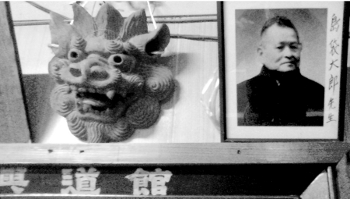In 1991, Murakami Katsumi (Murakami 1991: 190-91) published an article about the teachers of his teacher Shimabukuro Tarō. Motobu Naoki Sensei of the Motobu-ryū was so kind to share it with me. Thank you very much Motobu Naoki Sensei!
The following is my translation of it.
Shimabukuro Tarō and his Teachers
I think a list of the teachers of the late master “Aburaya Sanjin” (nickname) Shimabukuro Tarō Sensei can be used as a source of information on the history of martial arts in Okinawa.
Shimabukuro Sensei was born in Shuri’s “Three Places” (name that combines the three towns of Tounjumui [usually pronounced Torikohori, today’s Torihori], Akata, and Sakiyama to one place). I do not clearly know his date of birth, whether it was 1905 or 1906.

Shimabukuro Taro, original photograph by the author, shot at Matsubayashi Kodokan Honbu Dojo in Naha, 2009.
Shimabukuro Sensei practiced Makiwara under the guidance of his father from the age of seven. This was the first time that he was introduced to Karate. After that, until his fourth year in elementary school, he practiced the Kata of Naihanchin from Tokuda Anbun Sensei. In his fifth year, Gusukuma Shinpan Sensei became his class teacher and by the time he entered the (old system) middle school, he learned Pinan, Kūsankū Dai and Shō, Chintō, and in Bōjutsu Shūshi no Kon. Since he was sixteen years old, he learned Kata of Shuri–te by Chibana Chōshin Sensei. Afterwards, he learned Dōhai [Rōhai], Wansū and Wankan from “Iha-gwā no Nushi” from Tomari, and Sēsan and Pīcchūrin from Shinzato Jin’an from Naha.
He learned Karate with Kyan Chōtoku Sensei from Shuri and from Arakaki Ankichi Sensei until both the teachers were dead. His [Shimabukuro’s] favorite Kata were Kyan Sensei’s Chintō and Arakaki Sensei’s Sēsan.
From Soeishi Umikana Sensei he learned Chōun no Kon.
From 1925 he went to Ōshiro Chōjo Sensei’s house the whole year around to learn until Ōshiro Sensei died in 1932 [Note: Other authors said Ōshiro lived until 1935]. In addition, he also went to the house of Chinen Usumē, the teacher of Ōshiro Sensei, for a couple of years, where he learned Sakugawa no Kon, Shirotaru no Kon, and Yonegawa no Kon.
From venerable elder Kiyuna, he learned Passai and Kūsankū and from a Karate person from Shuri’s “Three Places”, called “venerable elder Nakandakari Manga”, he learned to use Keikōken (Chicken-Beak-Fist, AKA Ippon-ken, and Kosa in old Okinawan dialect) and Kumite.
From Mīhagi Tōma Shizen Sensei he learned Kumite, from venerable elder Tamana(ha) Hamagū he learned Jūjutsu-/Jūdō-like Jissen (combat) Kata, from venerable elder Teruya he learned the old style Kata of Passai, from venerable elder Ishikawa-gwā nu Kekkerē he learned Sai, Nunchaku, Gojūshiho, and Kama nu Tī, and from venerable elder Tawada nu Mēgantō he learned how to kick with the instep.
From venerable elder Maeshiro from Shuri’s “Three Places” he learned Kumite, from Yabiku Mōden Sensei he learned “Yabiku no Chōbō” (Yabiku’s long Bō) and Picchūrin, from Yabu Kentsū Sensei he learned Gojūshiho, from Go Kenki Sensei he learned Haku–Tsuru (White-Crane), from Miyagi Chōjun Sensei he learned Sanchin, from venerable elder Uechi (the founder of Uechi-ryū) from Nakijin he learned Sanchin, and from the venerable elder Ōshiro Myōjin from Tsuken Island he learned Chikin Bō (=Tsuken Bō).
From Motobu Chōki Sensei he learned Kumite, from venerable elder Tokumura from Shuri’s “Three Places” he learned the source-Kata (prototype) of Naihanchi, from venerable elder Asato he learned the source-Kata (prototype) of Passai, from Takamine nu Chān Sensei he learned how to fight using the geographical features (topography) in the field.
During his Karate life, Shimabukuro Sensei received the teachings of Karate and Kobudō from the above-mentioned 28 teachers.
Biblio
Murakami Katsumi: Kata no Kokoro to Waza. Shin Jinbutsu Ōraisha, Tōkyō 1991.
© 2017, Andreas Quast. All rights reserved.
